1
The development of Germany's long range U-Boats, brought the Battle of the Atlantic to the doorstep of St. John's. With its strategic geographical postition and its snug harbour, St. John's became a major wartime port.. Naval facilities sprung up around the city. The southside of the harbour, traditionally a fish processing area, became home to naval vessels. Further up the hills, oil storage tanks, barracks and training facilities were constructed. On the north side merchant wharves were replaced by a naval dockyard. Additional barracks and administration offices were built north of LeMarchant Road. Two hospitals were set up. Collectively these facilities were known as HMCS Avalon.2
St. John's HarbourCirca 1941
St. John's, Newfoundland, Canada
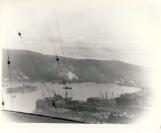 Credits:
Credits:John Sandison Collection
2007-2008 Album, Crow's Nest
3
Newfoundland's Importance during the Second World WarCirca 1941
St. John's, Newfoundland, Canada
 Credits:
Credits:Jacquey Ryan
Gary Browne
4
Well again the whole part of my book the Newfoundland Constabulary on the home front WW11 is a personal story to tell about the work of the Constabulary officers and the impacts it had upon their families. These men worked 7 days a week 12 and 14 hours a day right through the whole war. They had no time off and I know the story hasn't been told, that's the object of my book. But during the years of research for my book I really found out how important Newfoundland was to the allied war effort and I also found out Newfoundland was never given the credit it so rightly deserved and also I read an art saying how important Newfoundland and the Escort Force was to the Canadian Navy and to their tradition and it really made me appreciate how difficult of a job our servicemen had and especially our navy people, the Canadian Navy who left here, how important the Newfoundland Escort Force was and the corvettes and convoys coming out of Newfoundland, that especially after France had fallen the low countries were taken over by Germany, and Britain was starting to stagger, and they needed so much material and the material had to come via Canada and Newfoundland and someone had to escort them across, so I learned how important Newfoundland was to the allied war effort and I hope there is some researchers out there who come in and look at the navy point of view because I am handling the Police side of it but there is a tremendous story that hasn't even been scratched in my opinion of how important Newfoundland was to the second world war efforts. A lot of these men are dead because of their ages they would be in their late 80's but I think it has to be told5
Ship's Registration Papers from the Christoph Von Doornum, A German Merchant Ship3 September 1939
St. John's, Newfoundland, Canada
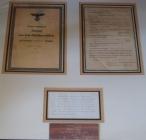 Credits:
Credits:Gary Browne
Jacquey Ryan
6
That when war was declared by Britain in 1939, that one hour after that declaration of war when Britain went to war with Germany because we were a British Dominion we automatically went into war as soon as Britain declared and one hour after war was declared in Britain now that's not very long, the Newfoundland Constabulary at Botwood were told to go aboard, there was an enemy ship, even though it was a merchant marine, in Botwood, that was loading some type of ore and it was at the wharf in Botwood and the Constabulary were told to go aboard and arrest the ship as a prize of war.. So this was only one hour after war had started which is pretty interesting For my book I interviewed a gentleman who was young at the time and he tells me it was so vivid in his memory that he was standing on his patio in Botwood and he looked out and saw at least 7 or 8 constabulary officers all big men in their black uniforms with rifles and their bayonets were fixed and the commanding officer was giving the words the drill and they were marching them down to the wharf in Botwood to arrest the ship, it was the Christoph Von Doornum, which was a German ship and he remembers actually seeing the police officers marching down towards that ship to take it as a prize of war and that would be interesting because that would be the first action in North America relating to the war, one hour after war was declared, so it was really interesting the Constabulary played a role. One of the officers who went on board who was in charge and he went to the captain of the ship, I think his name was Wilhelm Jostling and he told the captain that war had been declared and their ship was now under arrest as a prize of war and they would be detained all his crew, and his wife and young son, had been with him and soon as the officer told him he went to the back of the ship and took down the Swastika and then put up the Union Jack, I would love to know where that flag is today. So you had a police force, who were basically acting almost as a militia or army unit because at that time Newfoundland didn't have their own Armed forces so the police had to do it. These people were arrested and brought into St. John's at the time and they were called prisoners of war internees and the big problem then was where are you going to put them so I mentioned earlier about the Caribou Hut which was a huge hostel for the servicemen and I guess they had no where else to put them and Government owned the building (Caribou Hut) and upstairs was all vacant so they put these people up there until they got an internment camp ready which was down on Pleasantville, near Quidi Vidi Lake. So for the first while these internees were upstairs and that concerned people because the people who ran the club YM/YWCA, here you have all these servicemen and now we got I guess you could call them enemies, the enemy were here in their mind I suppose even though they were Merchant Seamen.7
Christoph Von Doornum Official CertificateShip's Certificate of the German Propellor Driven Steam Ship Christoph V. Doornum of Emden.
Registration of Ship
It is herwith certified by the indersigned office, Cristoph V. Doornum has been registered with a number 2572 with relevant certifications on February 2, 1939
Information is as follows
1. Name of Ship - Christoph V. Doornum
2.Type of Ship - Propellor driven steamer constructed of steel with two masts and one rigid deck
3. Signal of Differentiation - DJVA
4. Results of Official Measurements According to Paragraph 25 A2572 of the Ship's Measurements Legislation
Length: 109.00 meters
Width: 15.32 meters
Height: 7.3 meters - largest length of engine room 15.09 meters
This measurement was done according to ship's measurements legislation on March 1, 1895
(According to the jurisdiction of the Empire of 1895, page 161). These procedures were done completely and it is as follows:
Cubic Meter Registered tons
a) Total capacity of the ship 10627.4 3751.48
b) Net capacity 6345.5 2239.95
In addition to b) six thousand three hundred and forty five and 5/10 cubic meters
equals two thousand two hundred thirty nine and 95/100 registered tons.
5)Time of Construction month and year of the maiden voyage - 1928
6) Place of Construction - Sunderland
7) Home Harbour - Sunderland
It is also certified that the ship Christoph V. Doornum according to regulations concerning the flags, within the merchant ships - June 22,, 1899 (Jursdictions of the Empire page 319) in connection with the law of flying of the flags of September 15, 1935. (This is in the Book of Jurisdictions page 1145 and in accordance with the carrying of the flags for ships.The ship is authorized to carry the German Merchant flag with all rights and priveledges which belongs to a German Ship.
Certified: EMDEN February 11/1939
Court of Justice - Ship Registration Office
Buttwerweck, Blaschke
8
Blackout Markings on the VehicleCirca 1942
St. John's, Newfoundland, Canada
 Credits:
Credits:Ruby Moores Thomas Collection
Dawn Levitz Album
9
Blacked out HeadlightsCirca 1942
St. John's, Newfoundland, Canada
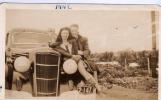 Credits:
Credits:Mary Noseworthy Hamlyn Collection
Hubert Short
10
The blackout was still in effect, I don't think the blackout was lifted until 1945, and by this time major changes, all vehicles had to have a 4" band of white paint all along the fenders, you know here's your car fender, you see pictures of them with this white paint on the fenders and the blackout masks on the headlight. The entire headlight was blacked out except for a little hole an inch and half wide on top and then circular on bottom and that's all the light you had if you were out driving. There wasn't an awful lot of civilians (had cars) personal motor cars were pretty scarce basically because of one thing, shortage of rubber. You couldn't get tires for personal use. The military had the whole business and the number of troops I mean it was hoards of'em and the harbour was down here, I have no idea of the names of them and there was warships, I can see them now, everyday. I used to stay with a cousin of my mother's down on Bond street there handy to where Bishop Spencer School used to be and her kitchen window looked straight out through the narrows and you could sit there all day and watch ships coming in and going out, in and out all day long.Hubert Short
11
Blackout markings on the VehiclesCirca 1942
St. John's, Newfoundland, Canada
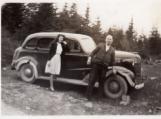 Credits:
Credits:Mary Noseworthy Hamlyn Collection
13
NL Constabulary had a special wartime security division that had to with aliens. Every person that came into Newfoundland by ai,r by ship, the manifest had to be taken, and all the manifest was sent to the Constabulary Security Division, so they had to check each and every name off the Black List that came from Britain, from the British Security Service. There was a wartime Blacklist and wartime German Agent List and all those people no matter where they came in, just stopped off to refuel in Newfoundland, that had to be sent in to the security division so you can imagine there was a tremendous amount of work for the police related to the war and of course who would be their other stakeholders were the military and especially the naval intelligence in St John's and there was an extremely close working relationship between the Constabulary Security Division and the Naval Intelligence here in St. John'. They worked very closely with each other during the war.14
C Block, HMCS AvalonCirca 1941
St. John's, Newfoundland, Canada
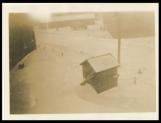 Credits:
Credits:Patrick Griffiths Collection
2007-2008 Album, Crow's Nest